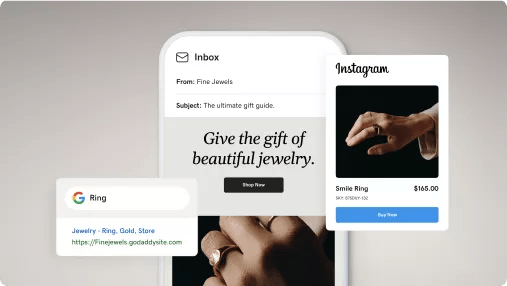Discover the Brilliance of The Ad Firm Carlsbad: Elevate Your Digital Presence Today
Discover the Brilliance of The Ad Firm Carlsbad: Elevate Your Digital Presence Today
Blog Article
Enhance Customer Experience and Drive Website Traffic With Receptive Website Design
In today's digital landscape, where users are accessing sites from a multitude of devices, responsive web style has actually become more vital than ever before. With its ability to adapt and perfectly change to various display dimensions, receptive layout not just improves user experience yet also drives web traffic to your website. But why is this design method so vital? How does it improve individual interaction and boost site traffic? In this discussion, we will certainly check out the crucial elements of efficient responsive layout, explore the very best practices for its implementation, and uncover the keys to improving user experience while driving even more website traffic to your web site.
Why Responsive Website Design Matters
Receptive web layout is an important facet of contemporary web growth because of its ability to make sure optimal customer experience across different gadgets and display sizes. With the spreading of smartphones, tablet computers, and other mobile phones, it has come to be critical for sites to adjust and offer seamless functionality no matter of the device being utilized.
The key reason receptive website design matters is that it enables individuals to have a consistent and delightful searching experience, despite the gadget they are making use of. A responsive web site automatically readjusts its layout, web content, and design components to fit the display dimension and resolution of the device, making sure that customers can quickly engage and browse with the internet site without any trouble or stress.
Furthermore, responsive website design likewise plays a considerable duty in seo (SEARCH ENGINE OPTIMIZATION) Search engines, such as Google, prioritize sites that are mobile-friendly and responsive in their search engine result. By integrating responsive design principles, websites can improve their visibility and ranking, causing increased natural web traffic and prospective clients.

Boosting Individual Involvement Through Responsive Style
Maximizing individual interaction is a key goal of responsive style, as it ensures that individuals can quickly accessibility and communicate with web site web content on any gadget. With the raising use of mobile phones and tablets, it is essential for internet sites to adjust to various screen sizes and resolutions. Responsive design makes it possible for web sites to automatically readjust their layout and content to provide a seamless customer experience throughout devices.
One of the primary methods responsive layout enhances customer involvement is by reducing load times. With a receptive web site, individuals do not have to wait on different mobile versions to lots, leading to quicker accessibility to content. This improved speed results in greater individual fulfillment and motivates them to spend even more time on the website.
In addition, receptive style improves customer involvement by boosting navigating and interface (Web Design). When a website is made responsively, buttons and menus are maximized for touch communications, making it simpler for users to navigate and communicate with the site on their mobile devices. This intuitive and straightforward experience keeps customers engaged and encourages them to check out more of the internet site
Additionally, receptive style enables better content presence and readability. By adjusting the layout and font style sizes to various devices, receptive web sites guarantee that customers can easily understand the web content and check out. This improves user involvement by minimizing the demand for scrolling or zooming to read the text.
Raising Site Website Traffic With Responsive Website Design
With the expanding appeal of smart phones, having a site that is receptive to various display dimensions and resolutions is essential for driving enhanced traffic. In today's digital landscape, users are accessing websites from a variety of gadgets such as mobile phones, tablet computers, and desktop computers. Each of these devices has different screen dimensions and resolutions, and if your site is not created to adapt to these variants, it can bring about an inadequate customer experience and a loss of prospective website traffic.
Receptive internet style ensures that your website looks and functions ideally across all gadgets. By utilizing versatile grids, fluid images, and media questions, receptive design enables your website to instantly readjust its navigation, content, and format to fit any type of screen dimension. This suggests that customers will have a smooth surfing experience no matter whether they are using a small smartphone or a huge desktop computer computer system.
Trick Aspects of Efficient Receptive Style
Efficient receptive layout incorporates a number of crucial components that make sure a seamless customer experience throughout different devices. This permits material to be shown in a legible and aesthetically attractive fashion on any kind of gadget.
One more essential element is media questions. These permit developers to use various styles and designs based on the attributes of the user's gadget, such as screen size and positioning. By utilizing media inquiries, developers can maximize the presentation of material for each and every gadget, making certain that it is easily available and legible.
Responsive photos are also vital in reliable responsive style. Photos that are as well large can reduce down web page lots times on smart phones, while pictures that are as well tiny may appear pixelated on bigger displays. By utilizing techniques such as responsive photo resizing and lazy loading, developers can make certain that pictures are properly sized and enhanced for every gadget.
Finally, this hyperlink reliable responsive design includes a mobile-first approach. This indicates developing and focusing on web content for mobile gadgets initially, and afterwards boosting the layout and expanding for larger screens. This technique makes certain that the most crucial web content is quickly available on smaller displays, while still giving an abundant experience on larger gadgets.
Finest Practices for Implementing Responsive Internet Design
Applying responsive website design needs cautious factor to consider of different best techniques to guarantee an ideal customer experience across various gadgets. Below are some essential best practices to follow when carrying out receptive website design.
To start with, it is vital to focus on mobile users. With the enhancing prominence of mobile phones, designing for mobile-first has become important. Beginning by developing for smaller screens and afterwards progressively improve the format for larger screens.

One more vital best method is to maximize photos for various screen resolutions. Large pictures can reduce the loading time of your internet site, specifically on mobile phones with slower connections. Use receptive images that can be resized based on the gadget's display resolution to improve efficiency.
Additionally, examination your site on various devices and screen sizes to make sure a regular and smooth experience. There are different testing devices available that can help you identify any type of problems and make needed adjustments.
Last but not least, focus on functionality and access. Make certain that your website is simple to navigate, with concise and clear content. Ensure that your website comes to individuals with specials needs and adheres to availability standards.
Conclusion
In final thought, responsive web style plays an essential check out here duty in boosting user experience and driving web traffic to internet sites. By taking on receptive layout concepts, internet sites can make certain optimal watching experiences across different devices, leading to enhanced customer engagement.
Maximizing user interaction is an essential objective of receptive style, as it guarantees that individuals can easily access and communicate with internet site content on any kind of gadget. Responsive layout enables sites to immediately adjust their design and content to give a seamless customer experience across devices.
Furthermore, receptive layout boosts customer interaction by improving navigation and user interface.Responsive pictures are also essential in effective responsive layout. By taking on receptive layout principles, websites can make sure ideal seeing experiences throughout different devices, leading to increased user involvement.
Report this page